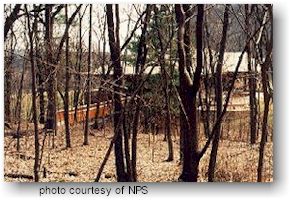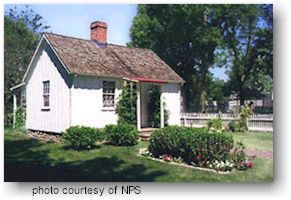


|

|
 Visitor's Center at Effigy Mounds National Monument |
 Herbert Hoover birth cottage at Herbert Hoover NHS |
| Effigy
Mounds National Monument - Prehistoric mounds are
common from the plains of the Midwest to the Atlantic seaboard, but only
in this general area were they constructed in an effigy outline of
mammals, birds, or reptiles. The Monument contains 1,481 acres with 191
mounds of which 29 are effigies. The others are conical, linear and
compound. Eastern Woodland Indians built these mounds from about 500 BC
to 1300 AD. Natural features in the monument include forests, tallgrass
prairies, wetlands and rivers.
Herbert Hoover National Historic Site - The Herbert Hoover National Historic Site buildings and grounds are preserved by the National Park Service to commemorate the life of the 31st President of the United States. Visit the small cottage where Hoover was born in 1874, a blacksmith shop similar to the one owned by his father, the first West Branch schoolhouse, and the Friends Meetinghouse where the Hoover family worshipped. Also located on the grounds are the Herbert Hoover Presidential Library-Museum, the gravesites of President and Mrs. Hoover, and a 76-acre tallgrass prairie. |
Lewis
and Clark National Historic Trail - This site
celebrates the heroic expedition of the Corps of Discovery, led by
Captain Meriwether Lewis and Captain William Clark. Thirty three people
traveled with them into unknown territory, starting near what is now
known as Wood River, Illinois in 1804, reaching the Pacific Ocean in
1805 and returning in 1806.
Mormon Pioneer National Historic Trail - Departing from Nauvoo, Illinois, in February 1846, thousands of Mormons crossed into Iowa seeking refuge from religious persecution. They spent the next winter in the Council Bluffs, Iowa and Omaha, Nebraska area. Early in 1847, Brigham Young led an advanced party west, generally paralleling the Oregon Trail, to Fort Bridger, Wyoming, where they turned southwest and eventually came to the Great Salt Lake. |
|
|
|
For more information visit the National Park Service website |
|||